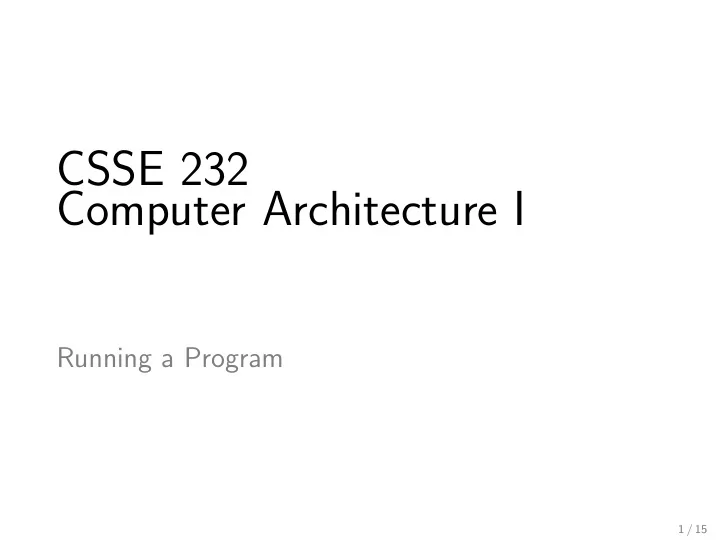

CSSE 232 Computer Architecture I Running a Program 1 / 15
Class Status Reading for today • 2.12, 2.13, 2.14, B.1-5 2 / 15
Outline • Compilers • Assemblers • Linkers • Loaders 3 / 15
Translation and Startup in C C program Compiler Assembly language program Assembler Object: Machine language module Object: Library routine (machine language) Linker Executable: Machine language program Loader Memory 4 / 15
Compiliers • Early software was written primarily in assembly language • Limited memory • Definition of compiler: A program (set of programs) that transforms high level source code written within a programming language (such as C) to assembly 5 / 15
Compiliers • First compiler written by Grace Hopper for the A-0 programming language (1952) • The compiler itself was written using assembly language • First self-hosting compiler developed in a high level language was for the Lisp (1962) • Usually written in the language that they compile • C compiler written in C • First compiler for a language would have to be compiled in another compiler (bootstrapping problem) 6 / 15
Compiler Structure • Input is high level code (C, etc.) • Checks syntax and semantics, performs type checks • Generates errors • Optimizes code • Translates the optimized code into assembly code • You can make a compiler in CSSE 404: Compiler Construction! 7 / 15
Assembler • Translates the assembly language into the appropriate binary equivalents ( object file ) • Most assembler instructions represent machine instructions one-to-one • Pseudo-instructions: figments of the assembler’s imagination • $at (register 1): assembler temporary move $t0, $t1 add $t0, $zero, $t1 → slt $at, $t0, $t1 blt $t0, $t1, L → bne $at, $zero, L 8 / 15
Object Files • Determine the addresses corresponding to the different labels • Object file contains • Object File Header: described contents of object module • Text segment: translated instructions • Static data segment: data allocated for the life of the program • Relocation info: for contents that depend on absolute location of loaded program • Symbol table: global definitions and external refs • Debug info: for associating with source code 9 / 15
Linker • Links object files together to produce an executable image • Merges segments • Resolve labels (determine their addresses) - example in branches and jumps • Patch internal and external references • Determine memory locations each module will occupy • Executable file has same format as object file but with no unresolved references 10 / 15
Dynamic Linking • Only link/load library procedure when it is called • Windows: Dynamic Link Library (dll) • Unix: Shared Object (so) • Different from static linking • Requires procedure code to be relocatable • Avoids image bloat caused by static linking of all (transitively) referenced libraries • Can automatically use new library versions 11 / 15
Loading a Program • Load from image file on disk into memory 1 Read header to determine segment sizes 2 Create virtual address space 3 Copy text and initialized data into memory • Or set page table entries so they can be faulted in 4 Set up arguments on stack 5 Initialize registers (including $sp , $fp , $gp ) 6 Jump to startup routine • Copies arguments to $a0 , ...and calls main • When main returns, do exit syscall 12 / 15
Review and Questions • Compilers • Assemblers • Linkers • Loaders 13 / 15
Program demo Demo of compiling, assembling, and linking 14 / 15
Project Project details on website • Write assembly code for the relprime() function. 15 / 15
Recommend
More recommend